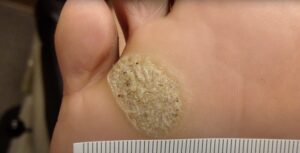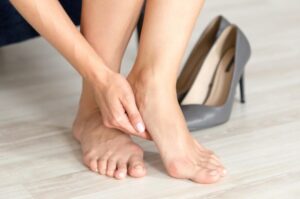Misunderstood by many, heel spurs are a perplexing mystery. In spite of their prevalence, misconceptions about heel spurs persist, leading to confusion and suboptimal treatment strategies. This article explores the intricacies of heel spurs, shedding light on their true nature, causes, symptoms, and implications. Our goal is to provide readers with comprehensive knowledge to effectively manage this common foot condition by unraveling the mysteries surrounding heel spurs.
Key questions about heel spurs
Sure, here are the questions addressed in the text:
- What are the symptoms of heel spurs?;
- What is the most common symptom of heel spurs?;
- How does pain associated with heel spurs typically feel?;
- What might cause difficulty in walking for individuals with heel spurs?;
- Is it possible for heel pain to worsen over time if left untreated?;
- Are there symptoms other than pain associated with heel spurs?;
- Do all individuals with heel spurs experience symptoms?;
- Is the size of heel spurs directly related to the severity of symptoms?;
- Why is it important to consult with a healthcare professional if experiencing heel pain suspected to be caused by heel spurs?
Let’s look at each of them in detail.
What Is Heel Spur?

The formation of heel spurs is often associated with repetitive strain or stress on the foot, such as:
- Poor Foot Mechanics: Abnormal foot mechanics, such as flat feet or high arches, can increase the risk of developing heel spurs;
- Excessive Weight: Being overweight or obese can put added pressure on the feet and contribute to the development of heel spurs;
- Footwear: Wearing shoes with inadequate support or poorly fitting footwear can lead to foot strain and heel spurs;
- Repetitive Activities: Engaging in activities that involve repetitive stress on the feet, such as running, jumping, or standing for long periods, can contribute to the development of heel spurs;
- Age: Heel spurs are more common in older adults due to the natural aging process, which can lead to changes in bone structure and tissue elasticity.
Although not always symptomatic, heel spurs can cause pain and discomfort, especially during weight-bearing activities such as walking or standing. The pain associated with heel spurs is often described as sharp and local to the bottom of the heel.
Diagnosis of heel spurs typically involves a physical examination and imaging tests, such as x-rays, to confirm the presence of the bony growth. Treating heel spurs focuses on reducing pain and inflammation and may include rest, stretching, orthotics, physical therapy, anti-inflammatories, corticosteroid injections, shock wave therapy, or surgery in severe cases.
Symptoms Of Heel Spur
Heel spurs may or may not cause symptoms. When symptoms do occur, they typically manifest as pain and discomfort in the heel area, particularly during weight-bearing activities. Here are common symptoms associated with heel spurs:
- Pain: Pain is the most common symptom of heel spurs. The pain is often described as sharp and localized to the underside of the heel. It may be worse in the morning upon waking or after periods of rest, as well as during activities like walking, running, or standing for extended periods;
- Tenderness: The affected area of the heel may feel tender to the touch, especially when pressure is applied directly to the heel spur;
- Inflammation: Inflammation may occur around the heel spur, resulting in swelling, redness, and warmth in the affected area;
- Stiffness: Some individuals with heel spurs may experience stiffness in the heel and surrounding tissues, particularly after periods of inactivity or rest;
- Difficulty Walking: Heel pain and discomfort associated with heel spurs can make walking difficult, especially upon initial weight-bearing after periods of rest;
- Radiating Pain: The pain from heel spurs may sometimes radiate to other parts of the foot, such as the arch or the ball of the foot;
- Worsening Pain Over Time: If left untreated, heel spurs can lead to worsening pain and discomfort over time, making it increasingly challenging to engage in normal activities.
It’s important to note that not all individuals with heel spurs experience symptoms. Some people may have heel spurs detected incidentally during imaging tests for unrelated foot problems. Additionally, the presence of heel spurs does not always correlate with the severity of symptoms. Some individuals with large heel spurs may have minimal or no symptoms, while others with smaller spurs may experience significant pain and discomfort.
If you suspect you have heel spurs or are experiencing heel pain, it’s essential to consult with a healthcare professional for an accurate diagnosis and appropriate treatment. Prompt treatment can help alleviate symptoms and prevent complications associated with heel spurs.
Consequences of Ignoring Heel Spurs
Ignoring heel spurs can lead to worsening symptoms and potential complications. Here are some consequences:
- Increased Pain: Heel spurs can cause significant pain, especially during weight-bearing activities like walking or running. Ignoring the pain can lead to increased discomfort and reduced mobility over time;
- Inflammation and Swelling: Ignoring heel spurs can result in chronic inflammation and swelling around the affected area, further exacerbating the pain and discomfort;
- Difficulty Walking: Severe heel spurs can make walking difficult and may even lead to limping or altering your gait to avoid putting pressure on the affected heel;
- Plantar Fasciitis: Heel spurs are often associated with plantar fasciitis, a condition characterized by inflammation of the plantar fascia—a thick band of tissue that runs across the bottom of your foot. Ignoring heel spurs can worsen plantar fasciitis symptoms, making it even more challenging to walk and stand comfortably;
- Bone Spurs Growth: Ignoring the underlying causes of heel spurs, such as repetitive stress or poor foot mechanics, can lead to further bone spur growth. This can exacerbate symptoms and make treatment more challenging;
- Chronic Pain: Without proper treatment, heel spurs can cause chronic pain that affects your daily activities, including work, exercise, and recreational pursuits;
- Bursitis: Heel spurs can irritate the bursa—a fluid-filled sac that cushions and lubricates the joints—and lead to bursitis. Bursitis causes additional pain, swelling, and tenderness in the affected area;
- Achilles Tendinitis: Ignoring heel spurs can also increase the risk of developing Achilles tendinitis, a condition characterized by inflammation of the Achilles tendon. This can cause pain and stiffness in the back of the heel and lower leg;
- Functional Limitations: Chronic heel pain from untreated heel spurs can significantly limit your ability to participate in physical activities, affecting your overall quality of life;
- Increased Risk of Injury: Altering your gait or favoring one foot over the other due to heel pain can increase the risk of falls and other injuries.
Overall, ignoring heel spurs can lead to worsening symptoms, decreased mobility, and potential complications that may require more extensive treatment in the future. It’s essential to seek medical attention if you suspect you have heel spurs to receive an accurate diagnosis and appropriate treatment to prevent further problems.
Preventive Measures and Podiatric Guidance
Preventive measures and podiatric guidance play a crucial role in managing and preventing heel spurs. Here are some recommendations:
- Proper Footwear: Wear supportive shoes with adequate cushioning and arch support, especially if you’re on your feet for extended periods. Avoid high heels and shoes with minimal support, as they can exacerbate heel pain and contribute to the development of heel spurs;
- Orthotic Inserts: Consider using orthotic inserts or custom-made shoe inserts to provide additional support and cushioning for your feet. Orthotics can help distribute pressure evenly and correct any biomechanical issues that may contribute to heel spurs;
- Stretching Exercises: Perform regular stretching exercises to improve flexibility and reduce strain on the plantar fascia and Achilles tendon. Focus on stretching the calf muscles, Achilles tendon, and plantar fascia to help alleviate tension and prevent heel spurs;
- Gradual Increases in Activity: Avoid sudden increases in physical activity or changes in intensity, as this can put excessive strain on your feet and contribute to the development of heel spurs;
- Gradually increase your activity level and incorporate rest days to allow your feet to recover;
- Maintain a Healthy Weight: Excess weight can put added pressure on your feet and contribute to the development of heel spurs. Maintain a healthy weight through a balanced diet and regular exercise to reduce strain on your feet and lower the risk of heel spurs;
- Proper Foot Mechanics: Pay attention to your foot mechanics and avoid activities that put excessive strain on your feet, such as running on hard surfaces or wearing unsupportive footwear. Practice proper posture and alignment to reduce stress on your feet and lower extremities;
- Regular Podiatric Checkups: Visit a podiatrist regularly for foot exams and to monitor any changes or symptoms that may indicate the development of heel spurs or other foot problems. Early detection and intervention can help prevent complications and improve treatment outcomes;
- Treat Underlying Conditions: Address underlying conditions that may contribute to the development of heel spurs, such as plantar fasciitis, flat feet, or high arches. Work with a podiatrist to develop a comprehensive treatment plan that targets the root cause of your symptoms;
- Rest and Ice: If you experience heel pain or inflammation, rest the affected foot and apply ice packs to reduce swelling and alleviate discomfort. Avoid activities that aggravate your symptoms and give your feet time to heal;
- Follow Treatment Recommendations: If you’ve been diagnosed with heel spurs or related conditions, follow your podiatrist’s treatment recommendations diligently. This may include physical therapy, corticosteroid injections, shockwave therapy, or surgery in severe cases.
By incorporating these preventive measures and following podiatric guidance, you can reduce the risk of developing heel spurs and minimize the impact of foot-related problems on your overall health and well-being.
Conclusion
To effectively address and stave off the discomfort associated with heel spurs, delving into their intricacies becomes imperative. By dispelling misconceptions and offering insights into the diagnosis, treatment, and prevention of heel spurs, individuals can embark on a proactive journey toward heel pain alleviation and foot health preservation.
Navigating the challenges posed by heel spurs necessitates a blend of education and guidance from healthcare maestros, notably podiatric virtuosos. With their sagacious counsel, individuals can orchestrate a symphony of strategies to reclaim mobility and revel in the harmonious rhythm of daily life.


